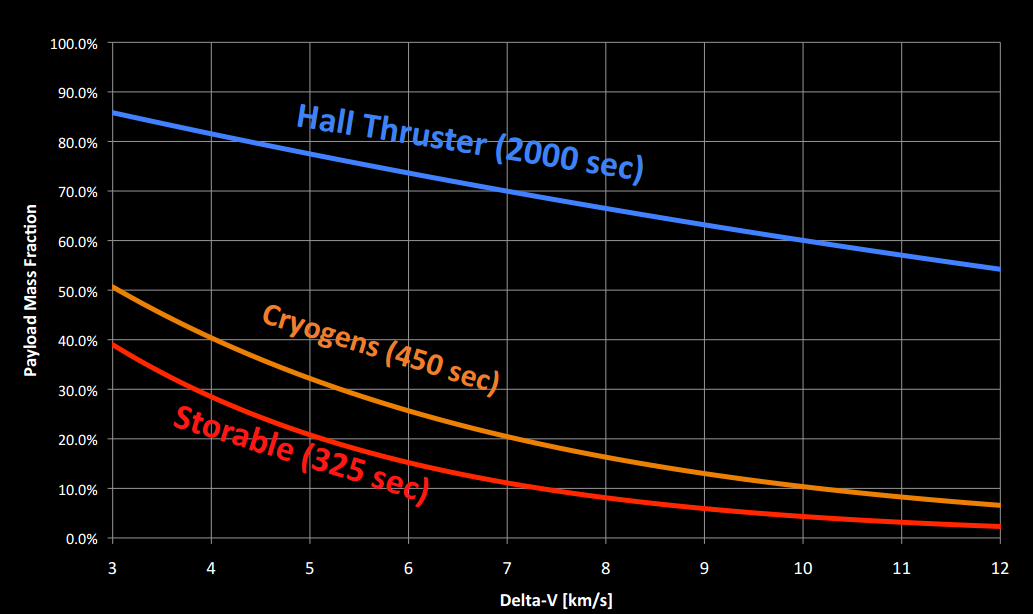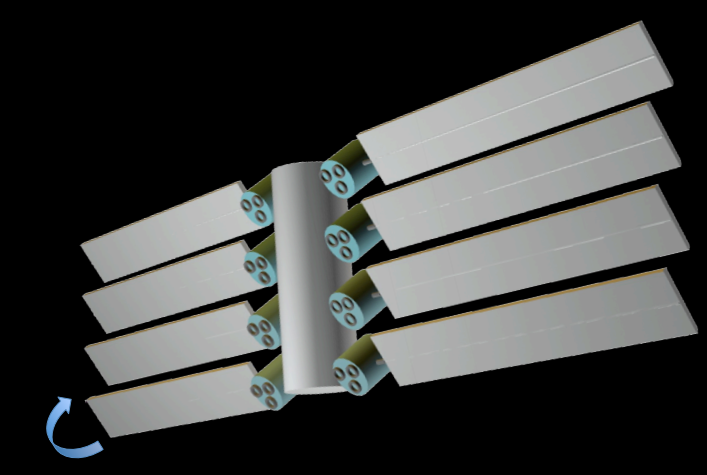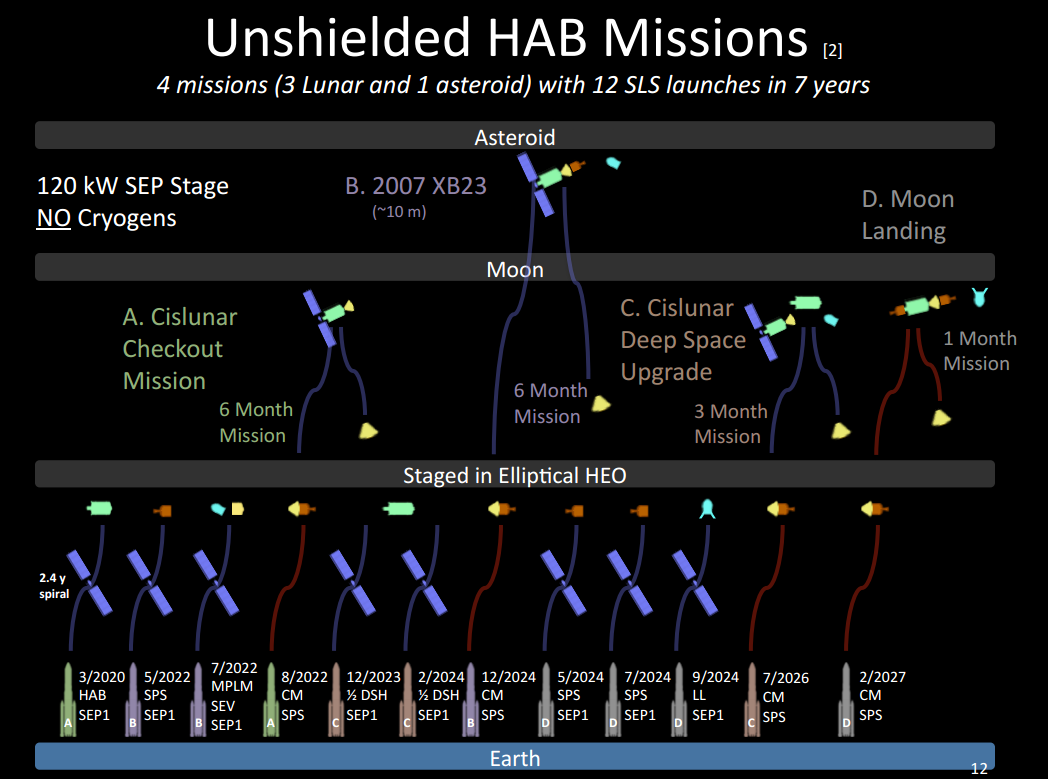A marriage of the tortoise and the hare may be the key to exploring the Solar System. At least, that’s the belief of Nathan Strange, a mission formulation systems engineer at NASA's Jet Propulsion Laboratory, who has outlined a plan to use hybrid chemical/solar-electric propulsion systems for the manned exploration of the Moon, Mars and the asteroids.
Getting around space is a matter of velocities. To get from Earth to Mars, for example, you need to change your velocity from that of Earth’s orbit to that of Mars. This change, or “delta-v,” is what space travel is. Everything else is just details. The problem is, how to change that velocity without expending enormous amounts or energy or taking forever to get where you’re going.

Currently, we rely almost entirely on chemical rockets for space travel. They do their job, but they do have their limitations. With their high thrust, chemical rockets can get payloads from one planet to another reasonably quickly, but their efficiency is low and the law of diminishing returns kicks in early. For missions of any length, the ratio of fuel to payload soon gets larger and larger until the craft is almost entirely made up of fuel. In other words, you start with a very large rocket, but not much of it gets to the other end.
Solar Electric Propulsion (SEP) systems such as ion drives and Hall thrusters seem like a better deal. Currently being used on a number of unmanned spacecraft, such as NASA’s Deep Space 1 and Dawn, they use electrically charged atoms of cesium or xenon for thrust instead of burning chemicals. They can run for years instead of minutes and they can reach the same velocities as chemical rockets. They’re also extremely efficient. For missions where a chemical rocket is only ten percent payload, an SEP vehicle can be 60 percent payload.

All that sounds great, but SEPs suffer from extremely low thrust – about the same as the weight of a coin resting on a table. In space, this is enough to move a vehicle at incredible speeds, but it also takes a very long time. Just spiraling out of Earth orbit can takes weeks or even months. For an unmanned probe this may be acceptable, but with a crew on board that means more supplies, extra radiation shielding, more time wasted in travel and less at the destination.
Strange and his team believe that the answer lies in combining these methods into a much more efficient and flexible system. The basic plan is to use heavy lifting rockets like NASA’s Space Launch System to boost components for a ship into low-Earth orbit. Once assembled and fueled, the SEP system would slowly push the unmanned vehicle into an elliptical high-Earth orbit. Once there, the crew would rendezvous using chemical rockets, which would also be used to push the vehicle out of orbit. After that, the SEP would propel the ship to its destination.

This combination reduces the travel time and the SEP allows for ships and supplies to be pre-positioned while the crew rendezvouses later. It also produces a net reduction in the amount of energy, though it would require flexibility as to destination and departure time. Indeed, where you would go with such a hybrid system would be a question of opportunities – which targets you could reach at a particular time and the particular state of technology.
Currently, the technology for such a hybrid system isn't available because both solar panels and electric thrusters operate at low a power level. Because of this, the team sees the system evolving as new technology comes on line. The way to do this is to match the missions to the capabilities and to remain flexible as to which missions to pursue.

As space-ready solar panels become larger and more efficient, they will be able to power larger thrusters or arrays of thrusters putting out hundreds instead of tens of kilowatts. This will mean heavier payloads such as small crew habitats being replaced with heavier, shielded ones and the addition of cryogenically-fueled rockets or even nuclear propulsion.
This approach also means that as the missions change or are completed the technology is preserved. Unlike the end of the Space Shuttle program where the space planes relegated to museums, the elements of the modular spacecraft can be reconfigured and reused. Even leftover fuel would be available for future missions.

Possible missions for the system range from the simple to the ambitious. The starting point would be cislunar missions, such at to the L2 Lagrange point between the Earth and Moon. According to Strange, missions to near-Earth asteroids would only be slightly more difficult and would use most of the cislunar equipment. With over 7,000 such asteroids available, missions could be dispatched on a regular basis as their launch windows presented themselves.
Once the capability to visit asteroids is achieved, the list of possible missions branches out. There could be a return to the Moon or visits to the Martian moons Deimos and Phobos with an eye to using them as staging areas for exploring Mars. Once sufficiently powerful thrusters are available, a manned Mars lander could be delivered to Mars orbit for a descent to the surface
Strange expects that solar panels of sufficient power for the first cislunar missions will be available by 2020.
Strange presented a paper on the topic – co-authored by Damon Landau, John Brophy, Raymond Gabriel Merrill and John Dankanich – at the Global Space Exploration conference in May.
Source: University of Texas [PDF] (an audio recording of the presentation is also available) via Yahoo News












